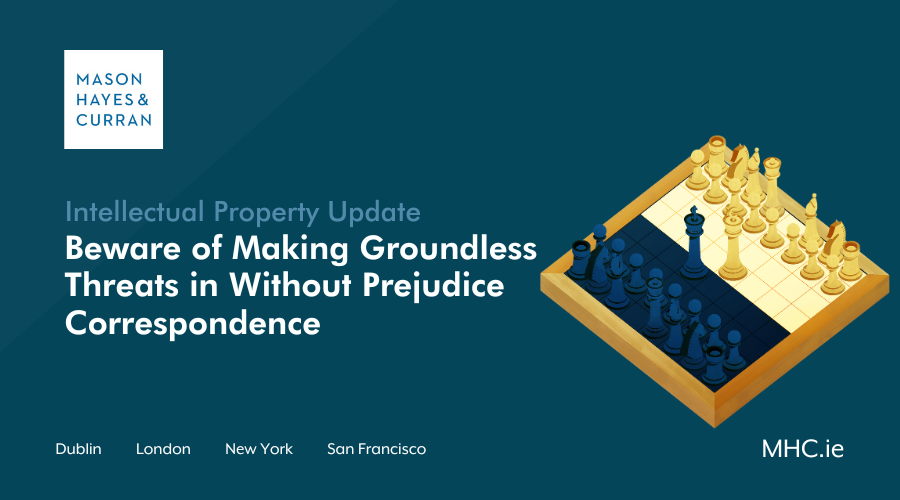
The public policy objective behind the “without prejudice” rule is to encourage parties to engage in genuine settlement. Our Intellectual Property team examines the use of the “without prejudice” rule in intellectual property litigation, particularly its interaction with groundless threats provisions.
Groundless threats provisions exist under both trade mark and patent legislation in Ireland but are not expressly provided for other IP rights like copyright.
Where the “without prejudice” rule usually protects the contents of negotiations from disclosure, as a matter of public policy, the rule will be lifted where the courts view these negotiations as ungenuine. We examine the use of “without prejudice” correspondence in intellectual property litigation in particular its interaction with groundless threats provisions.
What is “without prejudice”?
A letter written “without prejudice” provides protection for the contents of the letter during settlement negotiations. The purpose of the rule is to allow parties to engage in genuine settlement negotiations by encouraging parties to speak freely. The effect of the rule, an implied agreement between parties, is that statements or offers made in the course of negotiations may not be disclosed by the parties in a dispute. In other words, the parties cannot rely on the contents of “without prejudice” correspondence before the subsequent trial. In exceptional circumstances, where there has been a clear abuse of privilege, the courts will lift “without prejudice” protection.
In a recent decision in the UK[1], Master Marsh concluded that correspondence was not sent on a “without prejudice” basis and could be relied on by a third party. In assessing the nature of the letter, the judge considered:
- The manner in which the letter was drafted
- The essence of the chain of communication, and
- How a reasonably minded recipient would regard the letter
The letter in question was sent in response to an open letter which raised the possibility of alternative dispute resolution. One of the submissions of the sender was that it was marked in error. This case highlights the importance of considering the necessity of sending correspondence in contentious matters.
Groundless actionable threats
The origin of the groundless or unjustifiable threats provisions is explained in the UK Court of Appeal decision in Best Buy[2] a trade mark infringement case:
“During the middle of the nineteenth century, persons, often large companies, who claimed to be actual or potential patentees, would threaten, often without any justification, to initiate infringement proceedings against actual or potential customers of rivals in order to deter them from dealing with those rivals. In the absence of a statutory provision to the contrary, it would have been difficult for the rival or the customer to bring any claim based on such a threat, even if it caused them serious loss.”
The affected recipient may apply to the court for relief such as an injunction or damages for the infringed threat. Fox Group International Ltd v Teleta Pharma Ltd[3] demonstrates the importance of potential complainants establishing the accuracy of a claim. Fox had issued trade mark and passing off proceedings only to discover that Teleta had legitimately branded goods. In addition, Fox did not have the requisite rights to pursue such an action. Claimants should ensure that: “(i) …..that the suspect goods are, in fact, infringing and not legitimate branded goods; and (ii) check it had the legitimate right to register the trade mark it alleges has been infringed.”[4]
To succeed in such a claim the claimant must be able to demonstrate loss or damage. The UK IPEC found that a threat was not justified in Vanderbilt v Wallace & Ors[5]. However, the court concluded that there was no evidence that the recipient had suffered any loss or damage as a result of the threat made.
The only similar Irish case is Symonds Cider[6], a case that concerned the use of the term “scrumpy” for cider. Refusing the application for injunctive relief the court held that Section 24 of the Trade Mark Act 1996 relates to the threat of proceedings. In this case the proceedings were underway, therefore the matter was within the power of the court.
Groundless actionable threats & the “without prejudice” rule
In some circumstances the courts have found that “without prejudice” protection does not prevail where groundless threats are contained in the “without prejudice” communications. One of the leading UK cases is Best Buy[7], where the Court of Appeal held that threats in a letter with European-wide assertions would be construed as a threat of infringement proceedings in the UK. The case concerned whether inter-solicitor correspondence seeking undertakings to refrain from using a trade mark during a period of negotiation contained a threat of infringement proceedings. The judge at first instance had held that while the “September letter” contained a threat of infringement proceedings, it could not be relied upon as it fell within the protection of the “without prejudice” rule by virtue of containing settlement proposals. The Court of Appeal found that a threat must be considered objectively and need not be express. Ultimately the court found that the correspondence did not benefit from the “without prejudice” rule. A similar approach is likely to be taken in Ireland.
Look before you leap
There is doubt as to whether parts of a without prejudice letter can be excluded from reference in proceedings. To avoid a fight over the intention behind correspondence, claimants should consider whether it is worth sending a without prejudice letter and a separate open letter that can be relied on in court.
In intellectual property matters claimants should also establish that they have a solid case before threatening proceedings or issuing proceedings.
For more information and expert legal advice, please contact a member of our award-winning Intellectual Property team.
The content of this article is provided for information purposes only and does not constitute legal or other advice.
[1] Jones v Tracey & Ors [2023] EWHC 2256 (Ch)
[2] Best Buy Co Inc & Anor v Worldwide Sales Corporation Espana SL [2011] EWCA Civ 618
[3] [2021] EWHC 1714 (IPEC)
[4] [2021] EWHC 1714 (IPEC) at paragraph 1.
[5] [2017] EWHC 45 (IPEC)
[6] Symonds Cider v Showerings (Ireland) Ltd [1997] 1 I.L.R.M
[7] Best Buy Co Inc & Anor v Worldwide Sales Corporation Espana SL [2011] EWCA Civ 618




